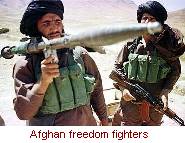|
|
|
|

|
Afghanistan
|
Afghanistan joins the United Nations.
A brief
history of Afghanistan
over the past 60 years.
Muhammad Daud becomes prime minister of Afghanistan. He begins to modernise the country and receive military and economic aid from the Soviet Union. Relations with the Pathan tribes of Pakistan deteriorates.
Biography of
Muhammad Daud.
Afghanistan changes from an absolute monarchy to a constitutional monarchy. The Afghan armed forces continue to depend on the Soviet Union for training and equipment.
Afghanistan is beset by serious economic problems. A group of young military officers, blaming the king for the economic problems, decide to depose the king. Muhammad Daud, the leader of the group, overthrows the king and declares Afghanistan a republic.
Daud faces pressure from the opposition party known as the People's Democratic Party of Afghanistan (PDPA).
Read more about the
PDPA.
PDPA leader, Noor Muhammad Taraki takes over as president of Afghanistan after Daud is unseated in a coup. Muhammad Taraki institutes Marxist reforms and forges closer ties with the Soviet Union.
The new government is unable to quell rival factions. By the middle of 1979, rebels control much of the Afghan countryside. In September, Taraki is killed and Hafizullah Amin takes power.
 Soviet forces invade Afghanistan and install Babrak Karmal, leader of the Parcham faction of PDPA, as president. Parcham is the Pro-Soviet faction of the PDPA. The new Soviet-backed government continues to fight against the rebels, who are aided by weapons and money from the United States.
Soviet forces invade Afghanistan and install Babrak Karmal, leader of the Parcham faction of PDPA, as president. Parcham is the Pro-Soviet faction of the PDPA. The new Soviet-backed government continues to fight against the rebels, who are aided by weapons and money from the United States.
Report on the
Soviet War in Afghanistan.
Short biography of
Babrak Karmal.
The United States supply the Afghan rebels with surface-to-air Stinger missiles. This forces Soviet aircraft and helicopters to suspend their low-level raids on rebel villages and strongholds.
Karmal is replaced by Muhammad Najibullah, a member of the Parcham faction who heads the Afghan secret police.
Najibullah announced a cease-fire, but the rebels refused his terms and the war continues in Afghanistan.
Gorbachev decides to pull out Soviet forces from Afghanistan. However, the Soviets continue to supply the Afghan regime with arms. Fighting continues between the Afghan regime and the rebels.
Afghan, Pakistani, and Soviet representatives in Geneva agree to a disengagement plan based on Soviet withdrawal by February 1989 and non-involvement in each other's internal affairs. The Soviets complete the evacuation on schedule but continue to supply the Kabul regime with large quantities of arms and supplies. The rebels continue to fight against the Afghan central with weapons supplied by the United States.
The Soviet Union and the United States sign an agreement to end military aid to the Afghan government and the rebels. However rebel fighting continues.
|




 Soviet forces invade Afghanistan and install Babrak Karmal, leader of the Parcham faction of PDPA, as president. Parcham is the Pro-Soviet faction of the PDPA. The new Soviet-backed government continues to fight against the rebels, who are aided by weapons and money from the United States.
Soviet forces invade Afghanistan and install Babrak Karmal, leader of the Parcham faction of PDPA, as president. Parcham is the Pro-Soviet faction of the PDPA. The new Soviet-backed government continues to fight against the rebels, who are aided by weapons and money from the United States.
